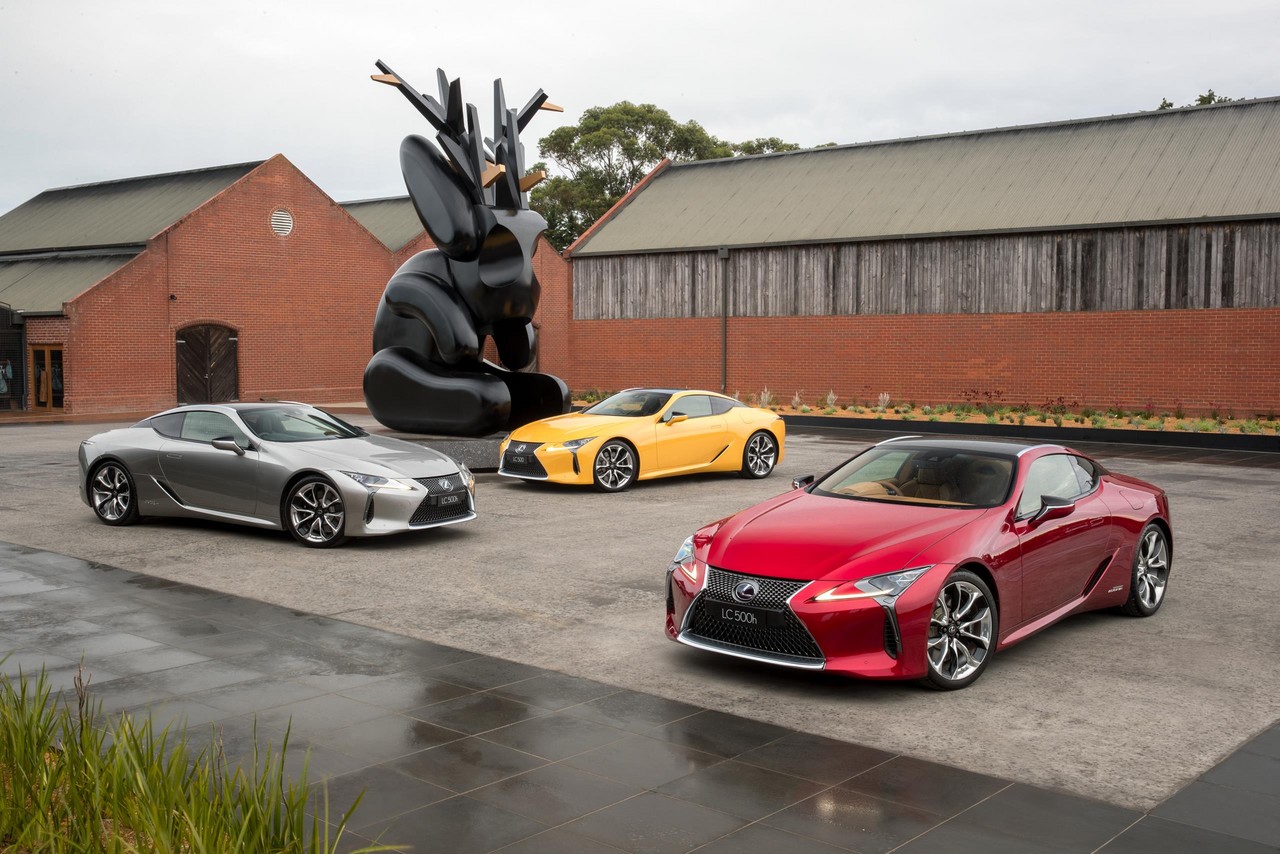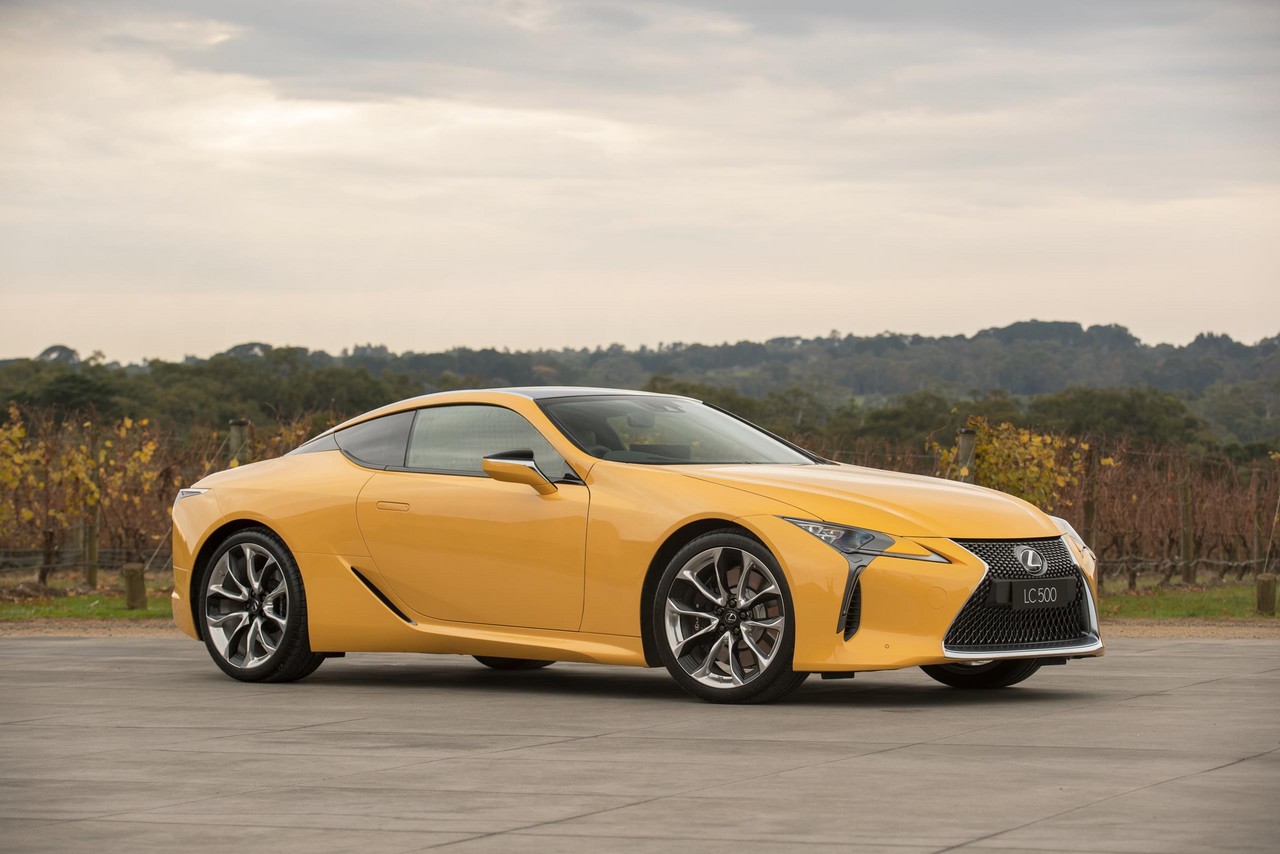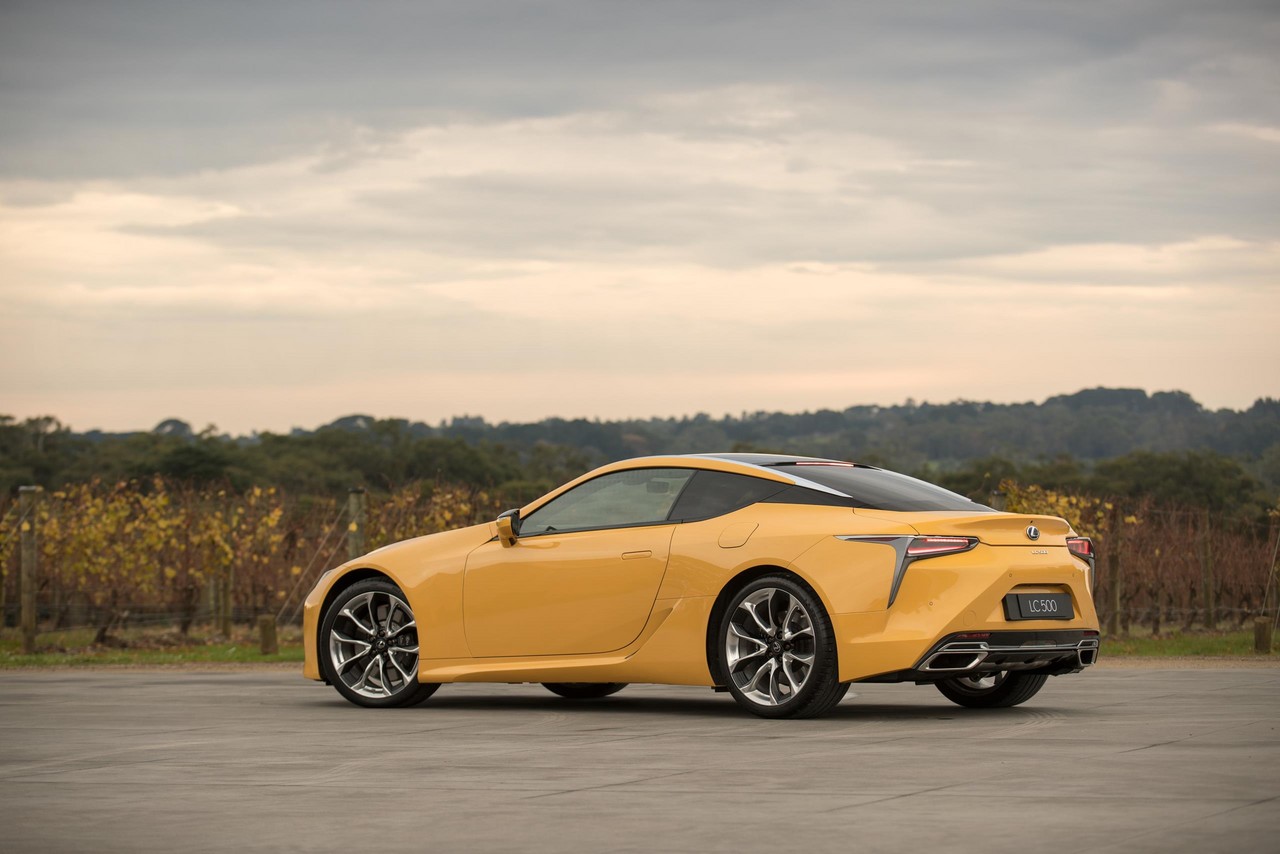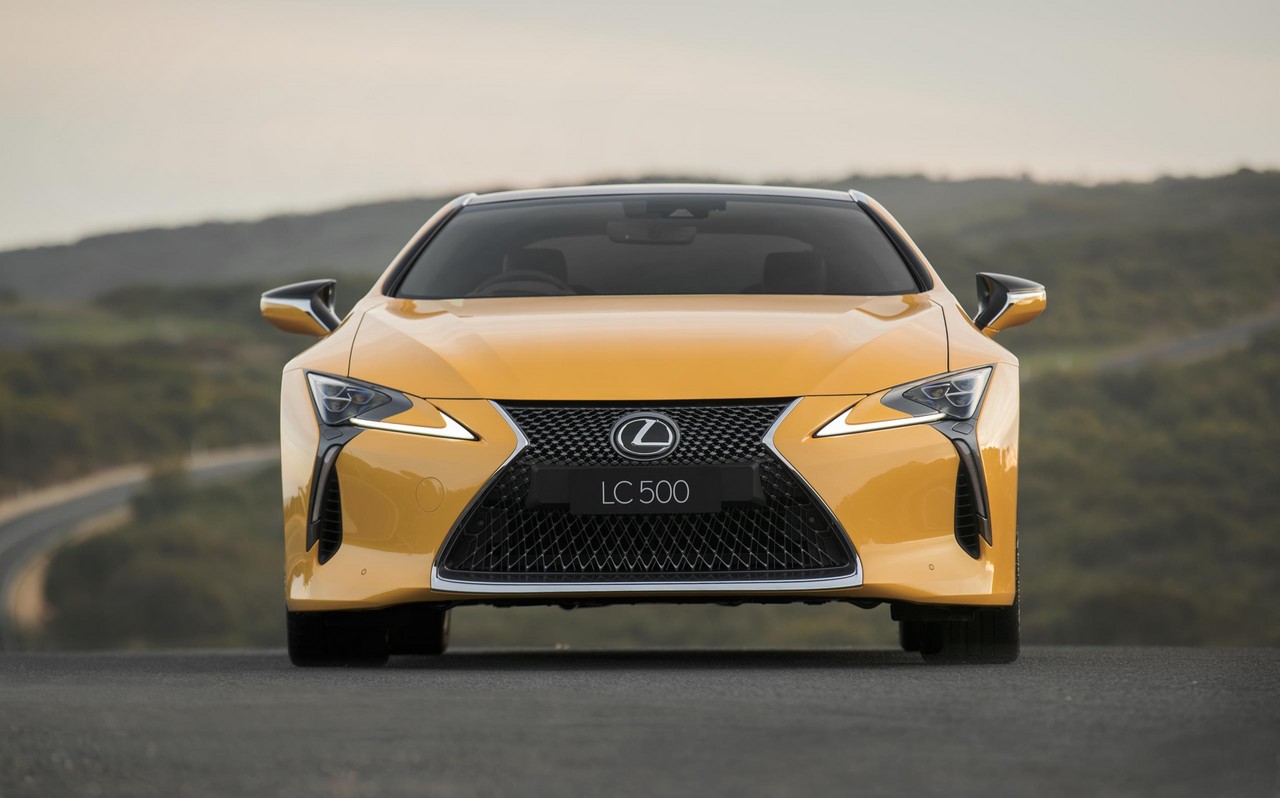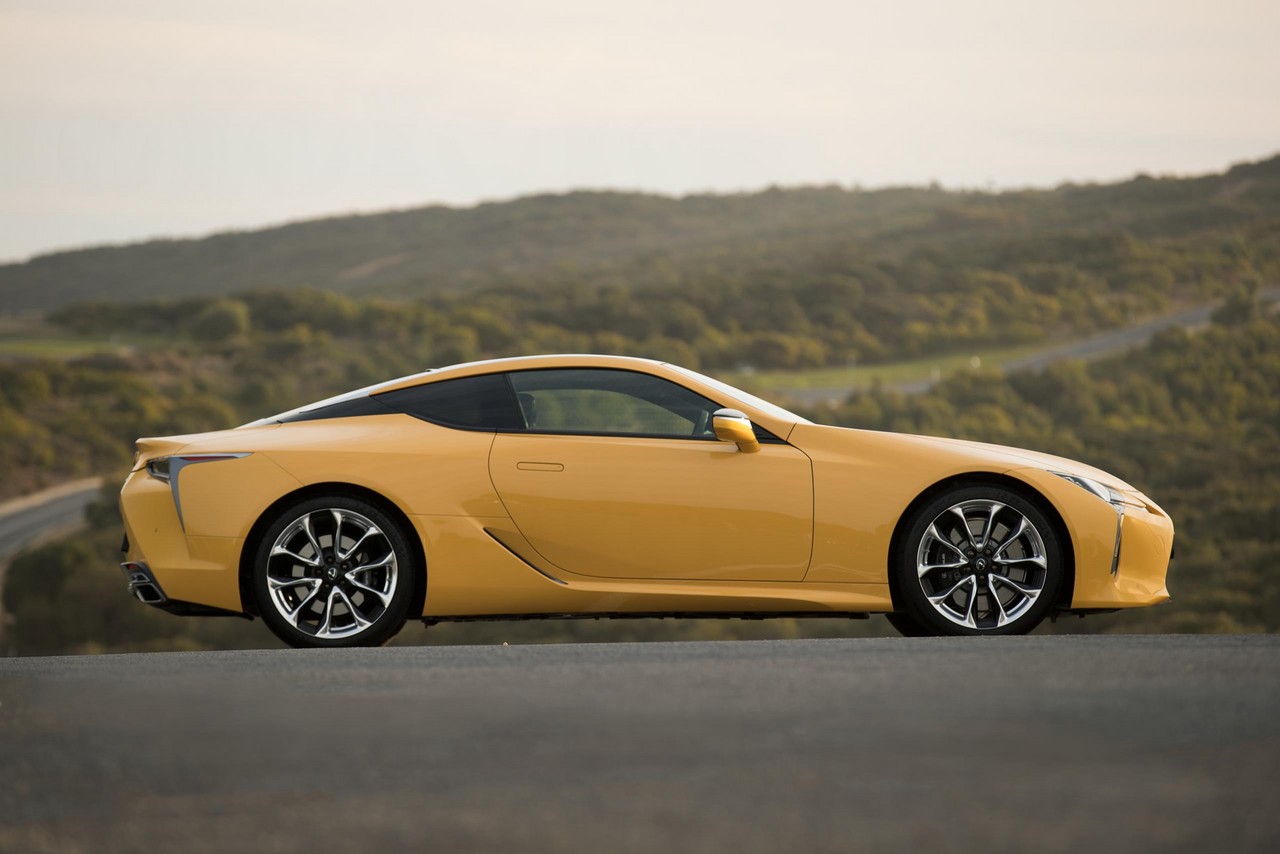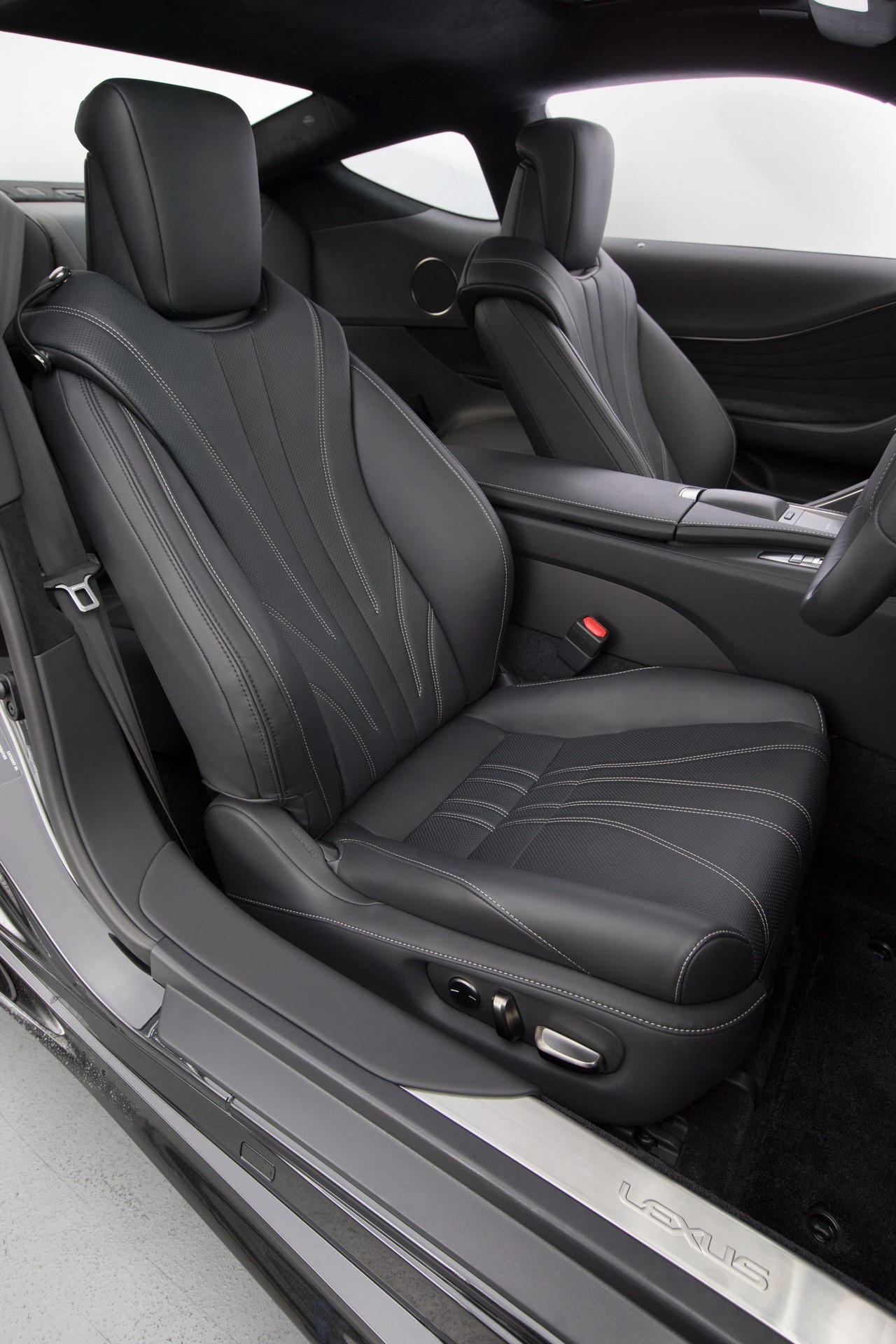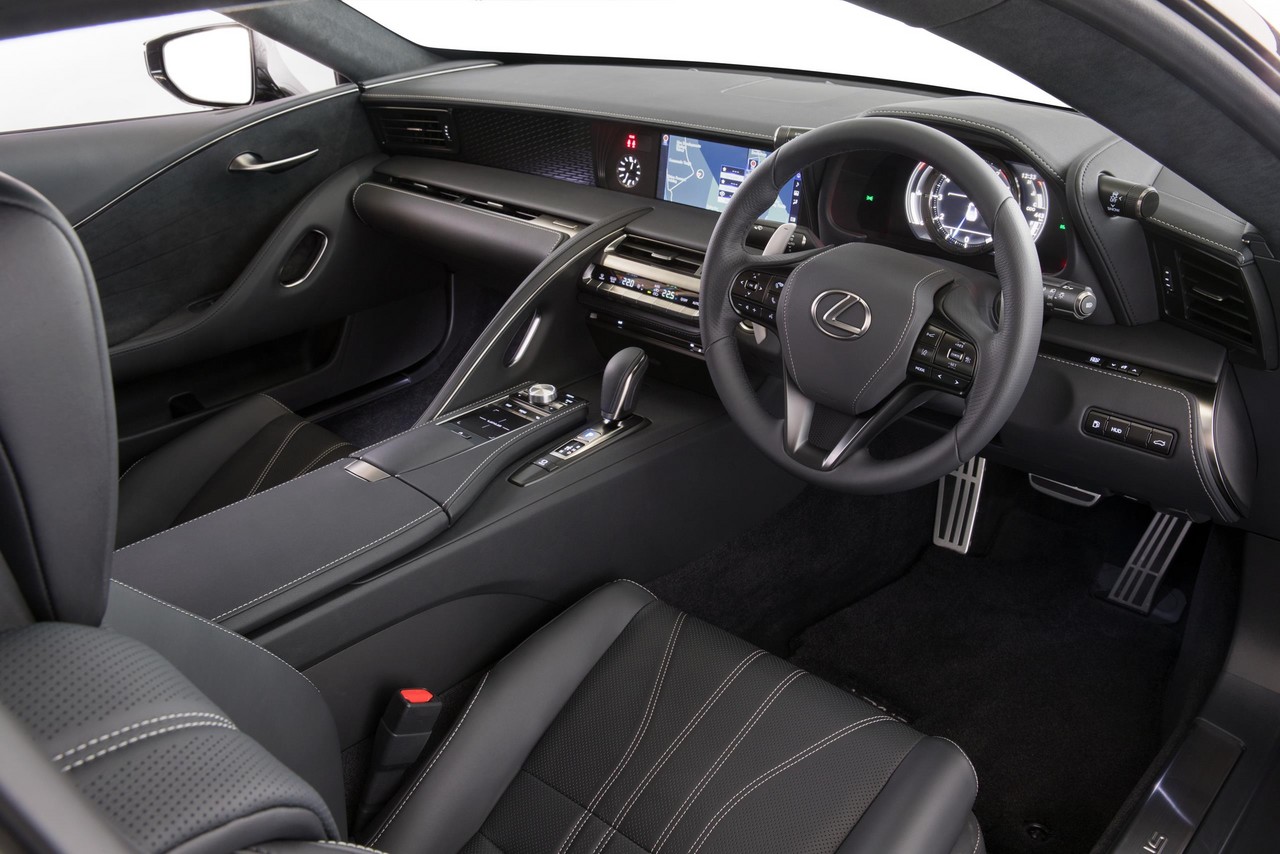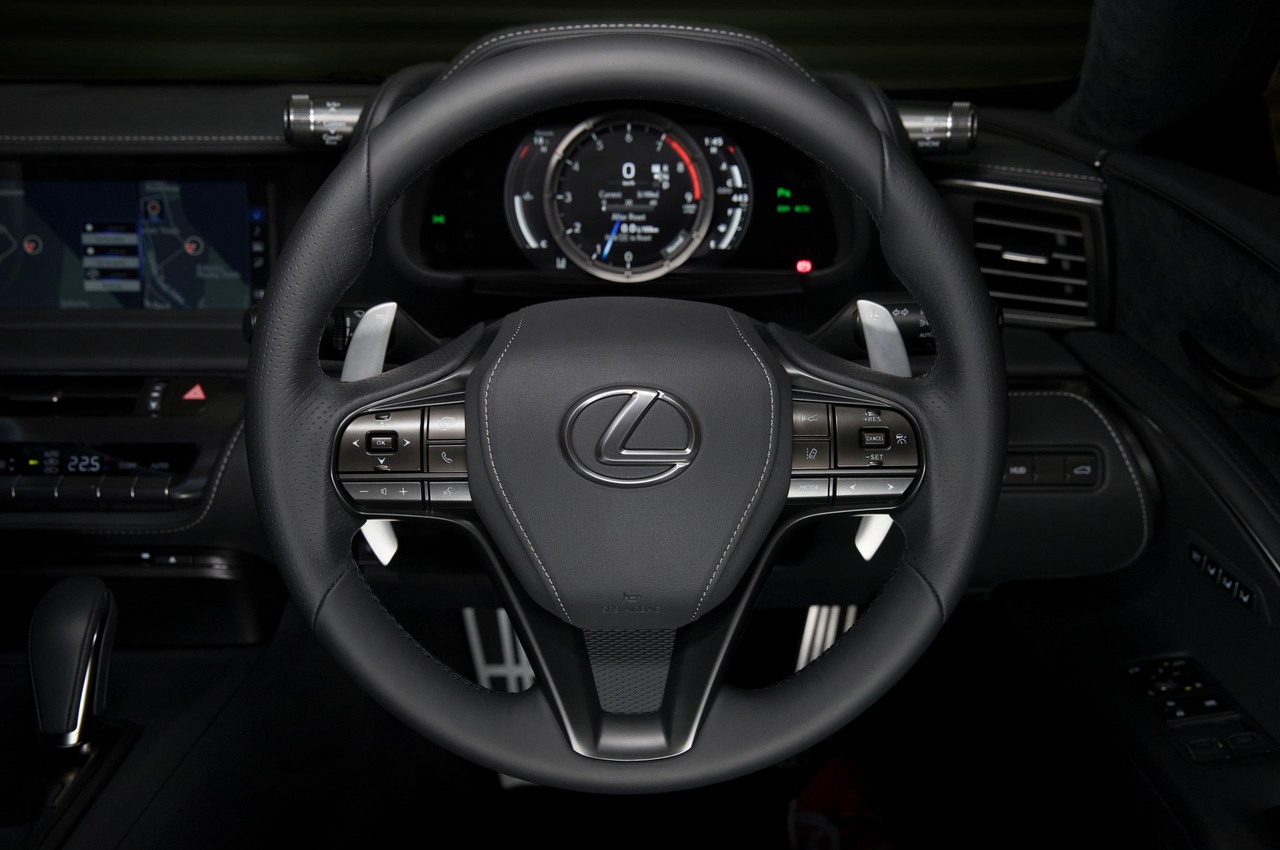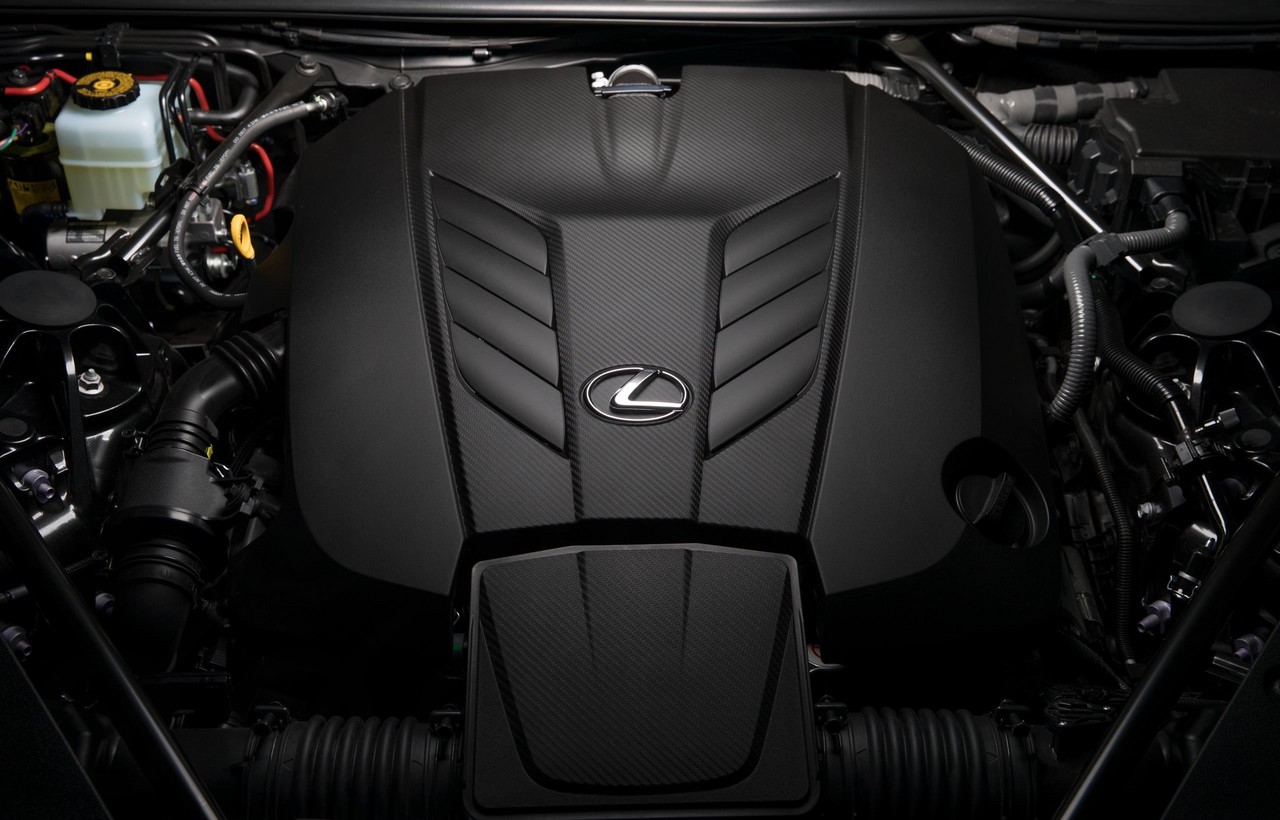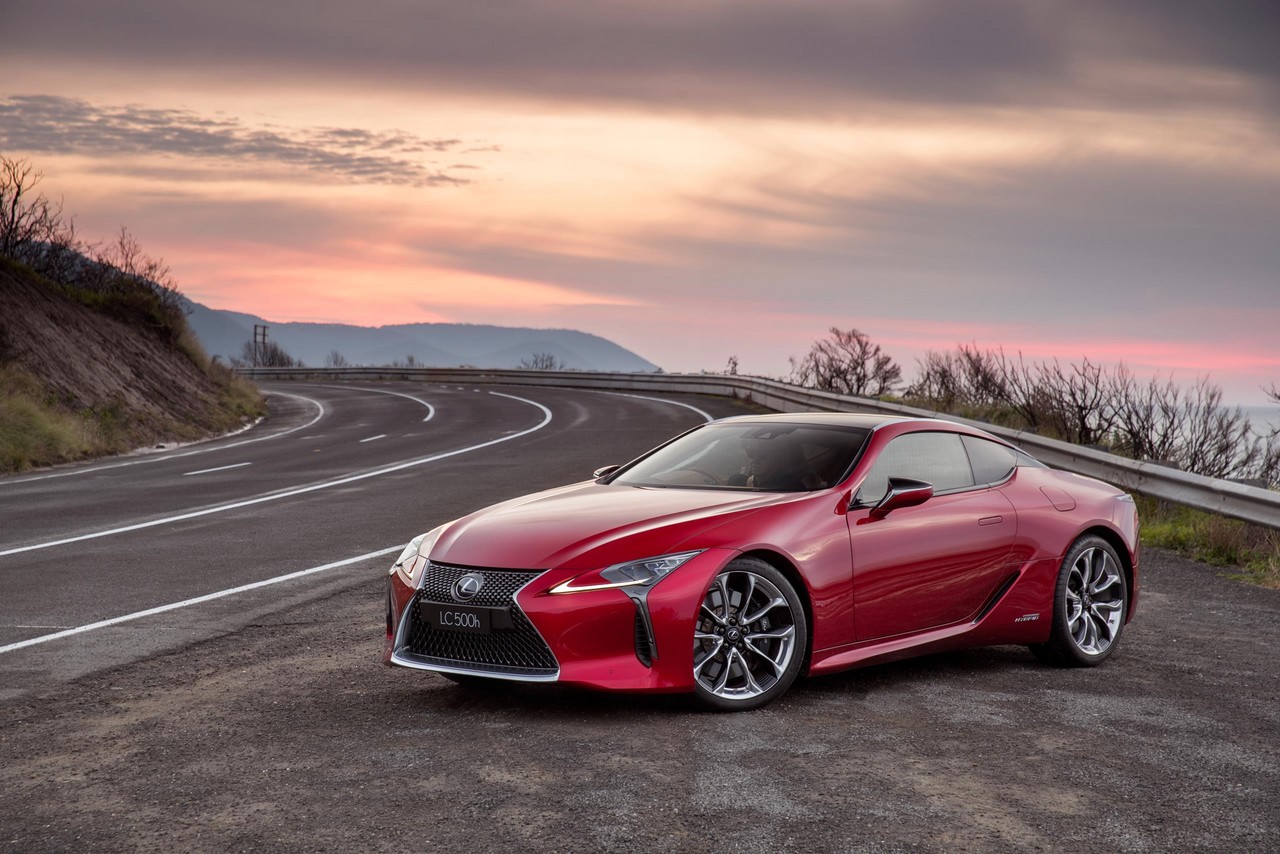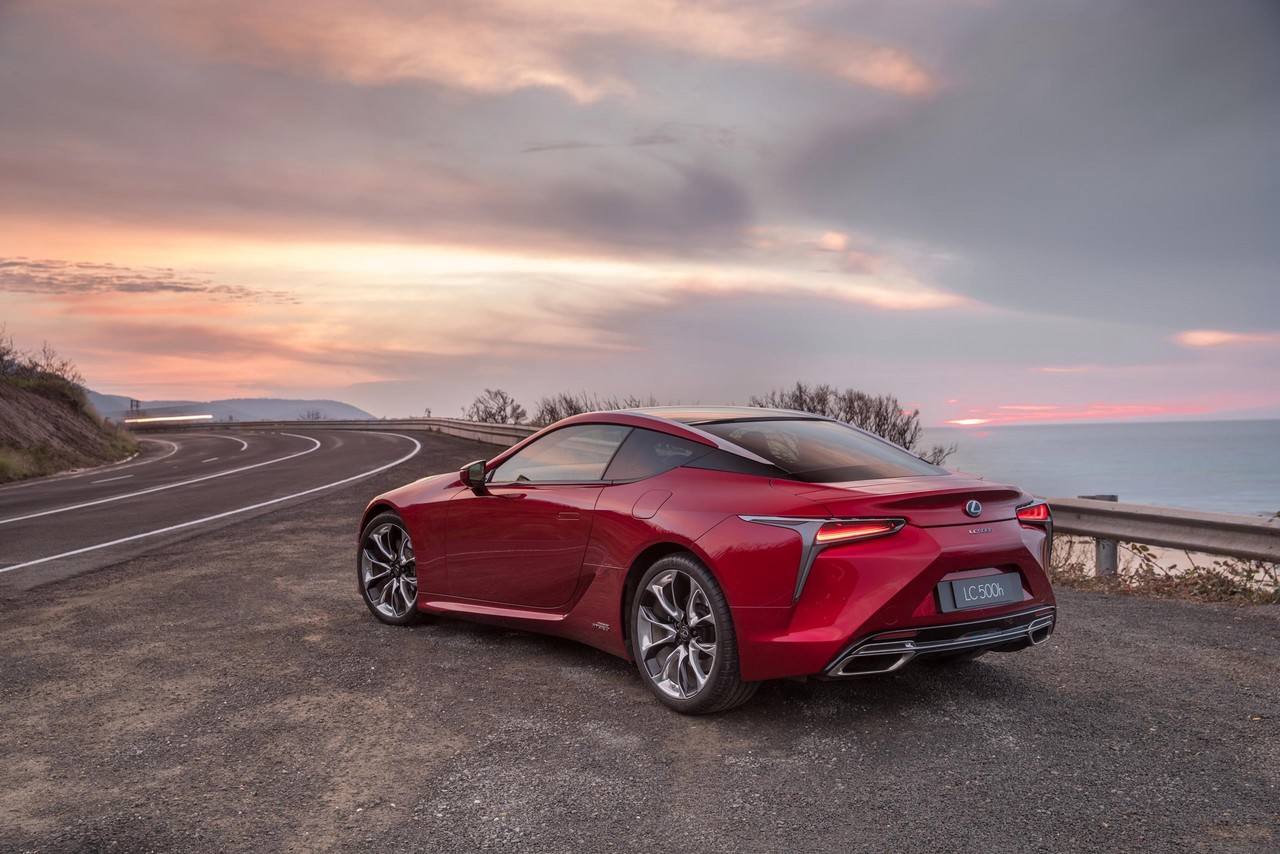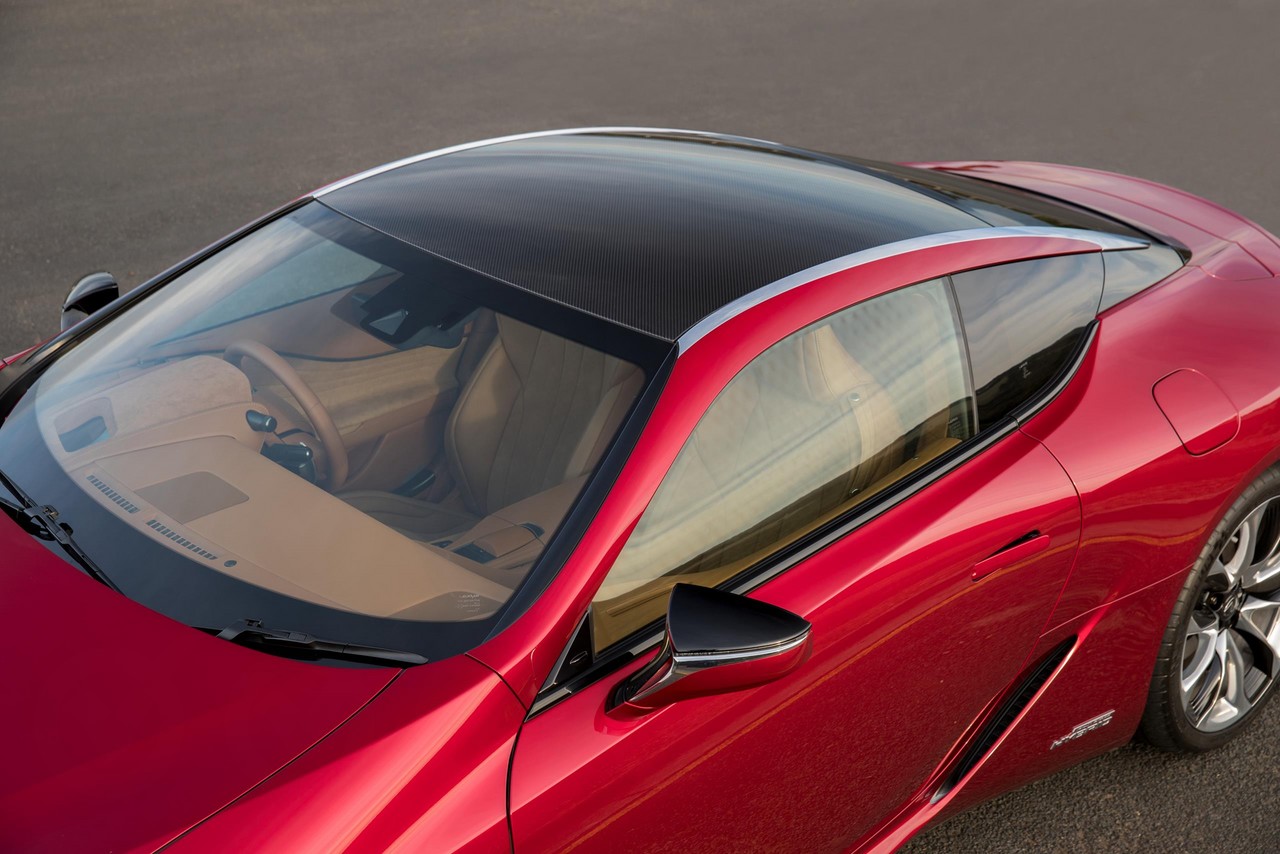
- For LC 500, sonorous and free-revving 2UR-GSE V8 engine
- For LC 500h, ‘multi-stage transmission’ helps overcome disconnected feel of CVTs
- Balanced and agile handling
- Impressive interior design and finishes…
- … although plastic gearshift paddles are a disappointment
- 21-inch wheels, runflat tyres and firm suspension produce an unsettled ride
- For LC 500, 10sp auto is continually hunting for the right gear
- Engines lack the mid-range response of turbocharged rivals
- Buttons and touchpad for infotainment system are frustrating to use
- Rear seats are too small for adults
Overview
Production of the Lexus Z100 LC commenced in March 2017 and it was released in Australia in June 2017. Manufactured at Toyota’s Motomachi Plant in Aichi, Japan, the Lexus LC was a rear-wheel drive, two-plus-two seat coupe and its range consisted of:
- The LC 500, powered by a 5.0-litre naturally aspirated V8 petrol engine that was mated to a ten-speed automatic transmission; and,
- The LC 500h, powered by a 3.5-litre naturally aspirated V6 petrol engine and a permanent magnet synchronous motor that was mated to a ‘multi-stage transmission’ that combined a four-speed automatic transmission and CVT.
Upon their release, both the LC 500 and LC 500h had a recommended retail price of $190,000 (excluding on-road costs such as stamp duty, registration and, where required, compulsory third party insurance).
Lexus LC 500: 2UR-GSE V8 engine
Like the Lexus RC F and Lexus GS F , the LC 500 was powered by the 5.0-litre 2UR-GSE V8 petrol engine which had a die-cast aluminium block, aluminium cylinder heads, a magnesium cylinder covers, double overhead camshafts per cylinder bank, four valves per cylinder (including titanium inlet valves), variable intake and exhaust valve timing (‘Dual VVT-i’), VVT-iE camshaft timing (i.e. an electrically-operated actuator controlled intake camshaft timing, whereas exhaust camshaft timing used a conventional hydraulic actuator), a two-stage intake system and a compression ratio of 12.3:1. For the LC 500, the 2UR-GSE engine is understood to have a 7300 rpm limit.
The 2UR-GSE engine had a twin injection fuel system (‘D-4S’) which combined direct injection with traditional port injection (the latter for more precise air/fuel mixing under low and medium load conditions). The 2UR-GSE engine operated on an Atkinson cycle at cruising speeds for improved fuel economy and an Otto cycle at higher speeds for greater power. The LC 500 required 98 RON premium unleaded petrol and complied with Euro 6 emissions standards.
According to Lexus, the LC 500 could accelerate from rest to 100 km/h in 4.7 seconds. Over the combined ADR 81/02 test cycle, fuel consumption for the LC 500 was 11.6 litres per 100 km.
Lexus LC 500h: 8GR-FXS V6 engine
The 3456 cc 8GR-FXS had a die-cast aluminium alloy block, an aluminium alloy cylinder head mounted on a steel-laminate type head gasket, a forged steel crankshaft with five balance weights, forged connecting rods, aluminium alloy pistons, double overhead camshafts (chain driven), four valves per cylinder actuated by roller rocker arms, D-4S injection (see above), an exhaust manifold that was integrated into the cylinder head, and a compression ratio of 13.0:1. Maximum engine speed for the 8GR-FKS engine was 6600 rpm.
While the exhaust camshaft for the 8GR-FXS engine enabled variable exhaust valve timing (VVT-i), the intake camshaft had a mid-position camshaft lock mechanism which could retard intake valve timing – known as ‘Variable Valve Timing – Intelligent Wide’ (VVT-iW) – which enabled the 8GR-FXS engine to:
- Start in the Otto cycle;
- Switch to an Atkinson cycle (i.e. shortened compression stroke and longer expansion stroke) for low-rev operations to minimise fuel consumption; and,
- Use an Otto cycle at higher engine speeds for greater power.
For the LC 500h, the 8GR-FXS engine was combined with a permanent magnet synchronous motor that drew power from 44.6 kW lithium-ion battery which had 84 cells and a nominal voltage of 310.8 volts. The LC 500h required 98 RON premium unleaded petrol and complied with Euro 6 emissions standards.
According to Lexus, the LC 500h could accelerate from rest to 100 km/h in 5.0 seconds. Over the combined ADR 81/02 test cycle, fuel consumption for the LC 500h was 6.7 litres per 100 km.
| Engine | Trans. | Peak power | Peak torque | |
|---|---|---|---|---|
| LC 500 | 5.0-litre 2UR-GSE petrol V8 | 10sp auto | 351 kW at 7100 rpm | 540 Nm at 4800 rpm |
| LC 500h | 3.5-litre 8GR-FXS petrol V6 | CVT + 4sp auto | 220 kW at 6600 rpm | 348 Nm at 4900 rpm |
| Permanent magnet synchronous motor | 132 kW | 300 Nm | ||
| Combined | 264 kW | N/A | ||
Lexus LC 500h: multi-stage transmission
The Lexus LC 500h was the first Lexus vehicle to have a ‘multi-stage hybrid transmission’. The multi-stage transmission combined a continuously variable transmission (CVT) with a four-speed Aisin transmission (mounted at the rear of the CVT). The CVT could simulate three ratios and, combined with three ratios in the mechanical transmission, the system provided nine ratios plus a final overdrive ratio (for a total of ten simulated ratios).
Significantly, the arrangement extended the hybrid operating range and enabled the LC 500h to drive in its electric-only mode at speeds up to 140 km/h; the driver was also able to select an ‘M’ drive mode in which gear changes could be performed via the steering wheel gearshift paddles.
Body and dimensions
The Lexus Z100 LC was underpinned by Lexus’ new ‘Global Architecture Luxury’ (GA-L) platform which will be used for the 2018 Lexus LS . The GA-L made extensive use of high-strength steel which, according to Lexus, achieves ‘a high degree of torsional rigidity that is more resistant to twisting forces than the exotic, carbon fiber-intensive [Lexus] LFA ‘. To enhance its rigidity, the Lexus LC had:
- Special braces in the engine compartment;
- Stiff aluminium front suspension towers;
- A ring structure near the rear fenders;
- 73 metres of adhesive to connect components; and,
- Where possible, line welds rather than spot welds.
The Lexus Z100 LC was 4770 mm long, 1920 mm wide, 1345 mm tall and had a 2870 mm wheelbase; its drag co-efficient was 0.33 Cd. To achieve its 52:48 front:rear weight distribution and enhance its balance, Lexus LC designers sought to position the engine and occupants in low, centralised locations, while the 12 volt battery was located in the boot. Mass reduction measures for the Lexus LC included aluminium door skins that were mounted on a carbon fibre inner structure and a composite boot floor.
Suspension and steering
The Lexus Z100 LC had multi-link suspension front and rear. The front suspension included double ball joints on the upper and lower control arms, with all but one of the control arms made of lightweight forged aluminium.
As standard, the Lexus Z100 LC was equipped with Lexus’ Adaptive Variable Suspension (AVS) which consisted of electronically-controlled dampers that adjusted damping forces according to inputs from sensors measuring G-force, steering input, yaw rate and wheel speed. According to Lexus, AVS had seven damping-force control strategies – including anti-dive and anti-squat – and provided 30 levels of damping force. When Eco, Normal or Sport S modes were selected via the Drive Mode Select system, AVS prioritised ride comfort; in Sport+ mode, however, AVS prioritised handling stability.
The Lexus Z100 LC had rack-and-pinion steering with electric power assistance.
Safety equipment
Standard safety equipment for the Lexus Z100 LC included dual front airbags, dual front knee airbags, front side airbags, full-length curtain airbags, ABS, electronic brake force distribution, brake assist, electronic stability control, traction control and front seatbelts with pre-tensioners and load limiters.
As standard, the Lexus LC was equipped with the Lexus Safety System + which included:
- Lexus’ Pre-Collision Safety System (PCS): used a grille-mounted radar sensor to scan for potential collision situations. If a collision risk was detected, the driver initially received a warning and Pre-Collision Brake Assist (PBA) activated to increase braking force when the system determined that the Lexus LC was in an emergency braking situation. If the relative speed between the driver’s vehicle and the obstacle ahead exceeded 30 km/h, PBA would automatically apply the brakes to reduce vehicle and reduce the severity of a collision. According to Lexus, the Pre-Collision Safety System could reduce vehicle speed by up to 40 km/h;
- All-speed Adaptive Cruise Control (ACC): used a millimetre-wave radar to detect vehicles ahead and determine their speed. Adaptive Cruise Control could then adjust vehicle speed – within a set range – to maintain a safe distance to the vehicle ahead;
- Lane Departure Warning (LDW) and Lane-Keep Assist (LKA): used a millimetre-wave radar and camera to monitor the vehicle’s position within its lane. If the driver unintentionally drifted out of their lane, LDW provided a warning via steering wheel vibrations and an audible tone. If ACC was active, Lane-Keep Assist (LKA) could apply counter-steering to keep the Lexus LC within its lane;
- Sway Warning System (SWS): monitored the vehicle’s position within the lane and the driver’s steering operations to detect sway, which could be caused by driver fatigue or inattention. If detected, the system alerted the driver by sounding a buzzer and displaying a warning on the multi-information display; and,
- Automatic High Beam (AHB): automatically switched the headlights between high and low beam to avoid dazzling other road users.
Beyond this, the Lexus LC was also fitted with:
- A Blind Spot Monitor (BSM): once the vehicle exceeds 40 km/h, sensors in the rear bumper could detect vehicles in the adjacent lanes. If the driver indicated to change lanes and a vehicle is detected, a warning tone would sound. The BSM could detect vehicles larger than an average 125 cc motorcycle and where the relative speed difference was up to 28 km/h; and,
- Rear cross-traffic alert: when reversing at speeds below 8 km/h, sensors in the rear bumper could detect approaching traffic travelling at speeds from 8 km/h to 28 km/h which may cross the vehicle’s intended path. If crossing traffic was detected, a warning tone would sound.
Wheels, tyres and brakes
The Lexus LC had 21-inch forged aluminium wheels with 245/40 RF21 front and 275/35 RF21 rear Michelin Pilot Super Sport tyres. For the Lexus LC, Lexus selected run-flat tyres to eliminate the need for a spare wheel.
The Lexus LC 500 and 500h had 338 mm by 36 mm ventilated front brake discs with six-piston brake callipers and 308 mm by 30 mm ventilated rear discs with four-piston callipers.
Features: Lexus LC 500 and LC 500 h
As standard, the Lexus LC was equipped with a Lexus audio and multimedia system which included a 10.3-inch display, digital radio tuner, Bluetooth mobile phone connectivity and audio streaming, voice recognition, satellite navigation with SUNA Live Traffic, Lexus Enform connected mobility and, with compatible smartphones, Siri Eyes Free and Miracast. For Australian-delivered vehicles, the Lexus LC had a 918 watt Mark Levinson premium sound system which had an eleven channel amplifier, thirteen (13) speakers and ‘Clari-Fi’ audio enhancement technology for compressed audio files. To reduce interior noise, the Lexus LC also had ‘Active Noise Control’ (ANC) which could detect low frequency noises entering the cabin and emit reverse phase sounds from the audio speakers.
Beyond this, standard features for the Lexus LC included dual-zone climate control, twelve-way power adjustable front seats with heating and ventilation, semi-aniline leather accented trim, three bi-LED headlamps with LED daytime running lights, dusk-sensing headlights, rain-sensing wipers, front and rear parking sensors, a reversing camera with guidelines (Lexus’ ‘Back Guide Monitor’), Parallel Parking Mode, a leather steering wheel with magnesium alloy gearshift paddles, a colour head-up display (150 mm by 50 mm), remote central locking with proximity key, power adjustable and heated door mirrors with folding function, power windows, a height and reach adjustable steering column, driver’s seat and mirror memory settings, a single instrument dial with an eight-inch multi-information display, an electrochromatic rear-view mirror, stainless steel scuff plates, a glass panoramic roof, tyre-pressure monitor, ambient lighting, a trip computer, an alarm and immobiliser.
LC 500: Active Exhaust and Sound Generator
The Lexus LC 500 has an active exhaust that can open baffles for a louder exhaust note. In Normal mode, the exhaust baffles open at engine speeds above 3500 rpm; in Sport mode, it is understood that the baffles are open at all times. Furthermore, the Lexus LC 500 has a ‘Sound Generator’ which consists of ‘tuned acoustic plumbing’ which enhances the engine’s ‘raucous melody into an aural thunder that helps distinguish the LC.’
Enhancement Pack
As a $15,000 option, the Lexus LC could be specified with an ‘Enhancement Pack’ which included:
- Dynamic Rear Steering (DRS) which could turn the rear wheels to complement the driving situation. At speeds of up to 80 km/h, DRS would turn the rear wheels in the opposite direction to the front wheels for tighter turns and increased cornering performance. At speeds above 80 km/h, the rear wheels turned in the same direction as the front wheels for greater stability;
- Variable Gear Ratio Steering (VGRS) which varies the steering ratio according to vehicle speed and steering operation;
- An active rear spoiler that deployed automatically at 80km/h;
- A carbon-fibre roof (in place of the glass roof);
- Combination leather-accented and Alcantara upholstery;
- Ten-way power-adjustable sports front seats with ‘more substantial’ bolsters; and,
- Carbon-fibre scuff plates.
For the LC 500h, the Enhancement Pack also included a limited-slip differential (LSD), though the LSD was already fitted as standard for the LC 500.
2018 Lexus LC Limited Edition (Morphic Blue)
Available in LC 500 and LC 500h models, the Lexus LC Limited Edition was released in Australia in May 2018. The Lexus LC Limited Edition could be identified by its ‘Morphic Blue’ iridescent paint finish that was inspired by the shimmering blue wings of the American Morpho butterfly. While the Morpho butterfly had colourless wings, their blue appearance was created by light interference on the microscopic lattice surface structure of the butterfly’s wings.
Lexus’ Morphic Blue paint finish incorporated 300 billion nano-structure pigment flakes to generate iridescence, giving the impression that the colour constantly changed with the light. According to Lexus, Morphic Blue was the result of 15 years of research to develop a deeper and more lustrous that was ‘more “blue” than anything seen before’. Furthermore, the paint was applied in seven layers and only two Morphic Blue cars could be produced in a day at Lexus’ Motomachi factory in Japan.
Inside, the Lexus LC Limited edition had a ‘Chrysalis Blue’ colour scheme that combined dynamic orange, blue and white hues. Furthermore, the interior featured semi-aniline leather accents, Alcantara and carbon-fibre scuff plates.
2018 Lexus LC Limited Edition (Zinnia Yellow)
In November 2018, limited Lexus LC 500 and LC 500h models were released which could be identified by their Zinnia Yellow paint finish. Inside, the limited edition Lexus LC models featured yellow Mikado contrast stitching for the seats, instrument panel, steering wheel and centre console, and yellow Mikado Alcantara door inserts. The limited edition Lexus LC models were also fitted with the ‘Enhancement Pack’ (described above) as standard.
Brochure
Related links
- Lexus Australia: 2017 Lexus LC 500 and LC 500h Press Kit (June 2017)
- Lexus Australia: Lexus LC – The Pinnacle of Design, Performance and Technology (June 2017)
- Lexus LC Global Launch Press Kit (December 2016)
- Lexus Australia: Lexus LC 500 Confirmed For Australia
- Lexus USA: Global Debut of All-New Lexus LC 500
- Behind the Wheel: 2017 Lexus LC 500 Review
- 2018 Lexus LC Limited Edition (May 2018)
